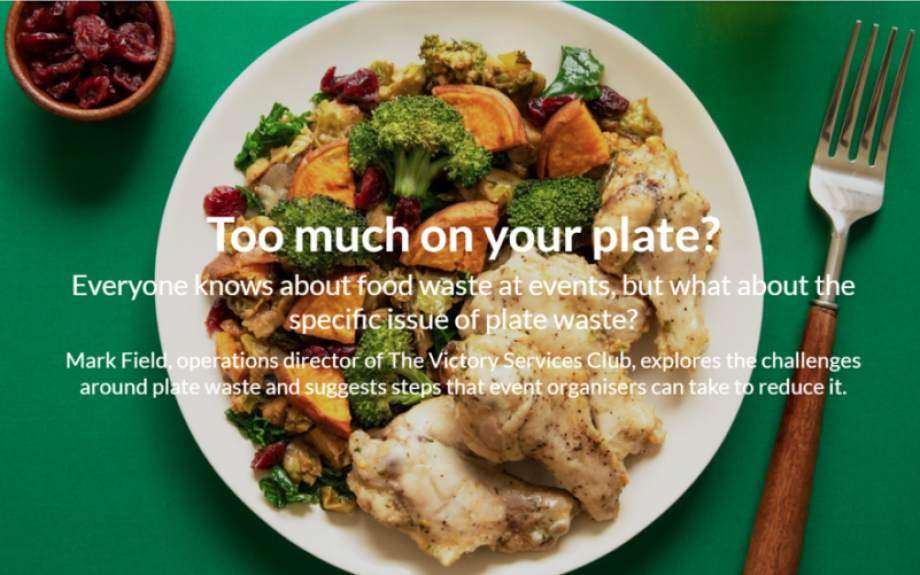Too much on your plate? Everything you need to know about plate waste
Mark Field, Operations Director at the Victory Services Club, explores the challenges around plate waste and suggests steps that event organisers can take to reduce it.
The original article is published in Meetings & the Incentive Travel magazine.
There’s a lot of talk in our industry about reducing food waste, but I haven’t read much about plate waste – and what event organisers and venues can do to help tackle it.
Plate waste refers to the uneaten food that is left on plates after a meal which can include both edible and inedible portions of food, such as bones, skin, and peels. According to a study by the Waste and Resources Action Programme (WRAP), the average plate waste per person in the UK is 71g per meal, which equates to approximately 9.5 million tonnes of food waste annually in the UK.
While a lot of kitchen food waste can be re-purposed (bones and peelings into stock for example) plate waste cannot be re-used and is either wasted or put into compost.
I have seen first-hand the amount of food waste that can occur at events and much of it is plate waste.
Despite the best efforts of our chefs to reduce food waste when preparing dishes, one of the biggest reasons for plate waste is the failure to properly gather dietary requirements from delegates in advance. Our chefs are always able to cope with dietary requests on the day, but for every last minute dietary request they conjure up, there is a plate of uneaten food that potentially goes to waste – and this has a negative impact on the environment.
We all know that in recent years, there has been a significant increase in the number of dietary requirements at conferences in the UK. This is due to a number of factors, including an increase in the number of people with food allergies and intolerances, as well as an increased awareness of different dietary requirements, such as veganism and vegetarianism.
However, there are a number of steps that event organisers can take to reduce plate waste at their events.
Consider and collaborate with your audience before selecting your menu
The demographic of your audience should influence what you choose; an older audience may appreciate smaller portions, or two course rather than the traditional three.
Sharing the menu in advance may flag up some issues too; if you are proposing lamb, but 50% of your audience don’t like it, you can then look at choosing a more appropriate meal option.
Gathering dietary requirements in advance
Meals with one or more dietary requirement make up around 40% of the dishes we serve at the Club – that’s a lot of potential plate waste.
Event organisers have a responsibility to ensure that their delegates’ dietary requirements are met, but they also have an obligation to gather this information in advance and to feed this to their venue.
By knowing in advance what dietary requirements are needed, caterers and venue chefs can prepare just the appropriate amount of food, reducing the risk of excess food being thrown away.
Offering smaller portion sizes
Another way to reduce plate waste is to offer everyone the option of smaller portion sizes.
This not only helps to reduce the amount of food wasted, but it can also be beneficial for attendees who prefer smaller portions.
Encouraging attendees to only take what they need
Organisers can also encourage attendees to only take what they need, by providing information on the amount of food that is available and what will be available to eat later in the afternoon break or at dinner.
They can also encourage attendees to take smaller portions if they are unsure of how much they will eat.
Work with your venue
All venues take dietary requirements very seriously and work closely with their clients to ensure that their delegates’ needs are met.
We understand that it can be challenging to cater for a wide range of dietary requirements, but our chefs have developed a range of menu options that cater to the most common dietary requirements including gluten-free, vegan, vegetarian, and halal options.
Turn your menu on its head
If you have a high percentage of dietary requirements, consider how you can adapt the whole menu to suit your biggest dietary group. Our chefs have created entire menus that are naturally (and not obviously) gluten-free, dairy-free or vegan. They then have a universal platform to add different options too – instead of the usual approach which focuses on taking things away and replacing.
Plate waste is a significant issue at events, and it is important for event organisers to take proactive action to reduce it.
By gathering dietary requirements in advance and taking other measures to reduce excess food, event organisers can help to reduce the negative impact of plate waste on the environment and ensure that their events are as sustainable as possible.
Mark Field is Operations Director at the Victory Services Club, Marble Arch, London. He also sits on the Venues of Excellence Advisory Board.
Photo by Ella Olsson on Unsplash

